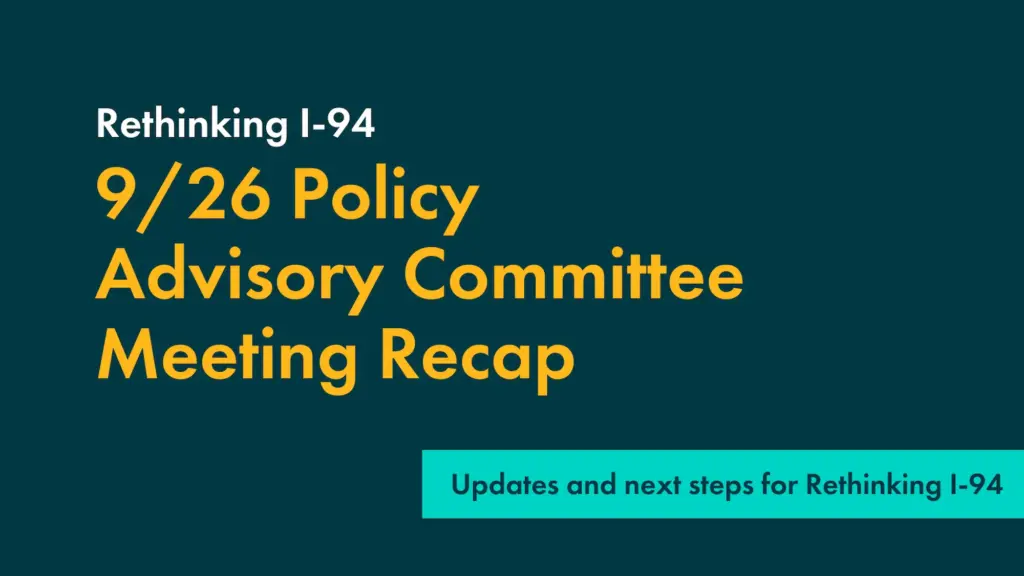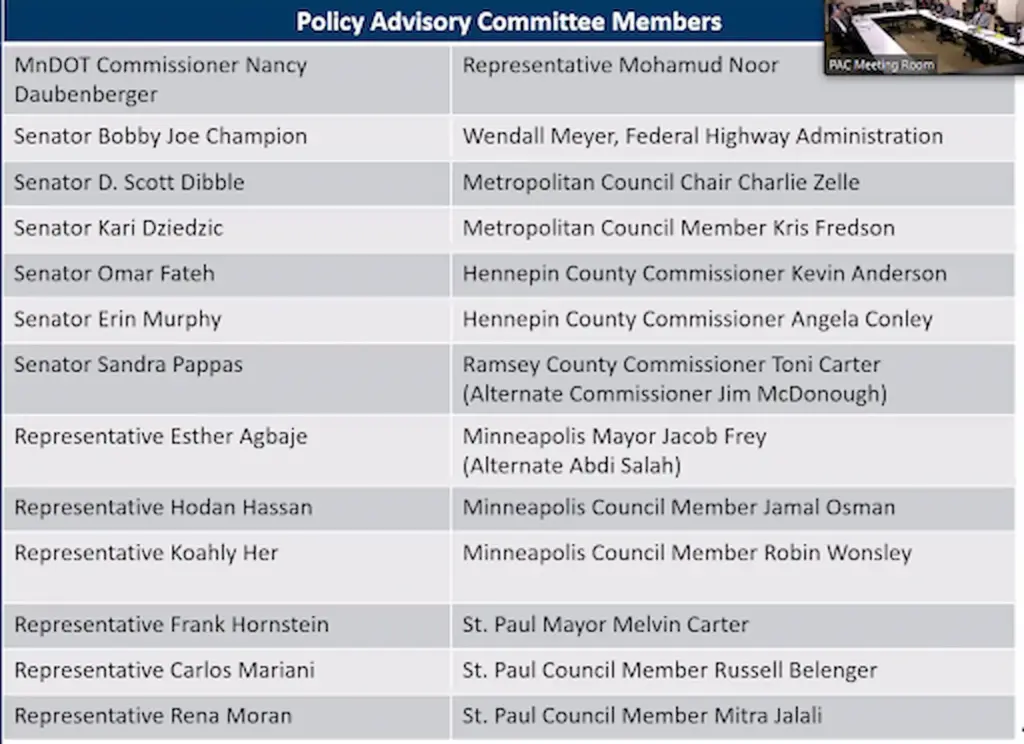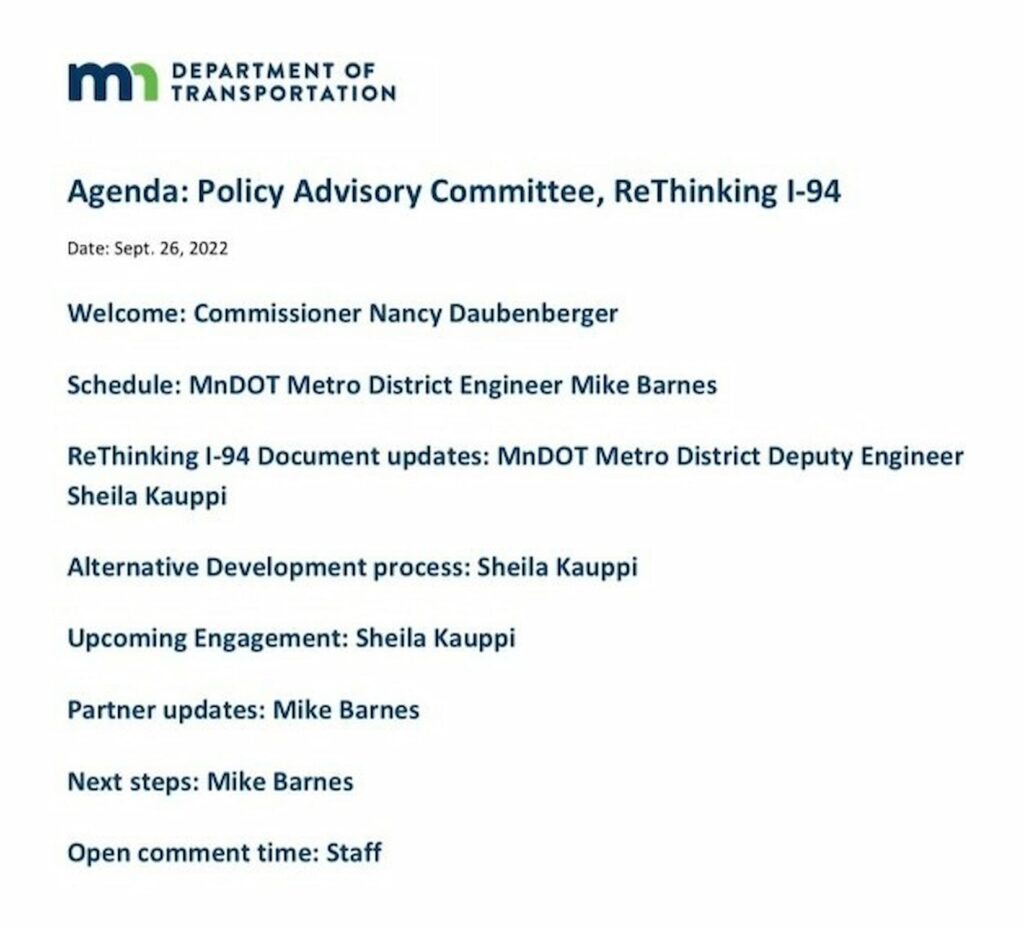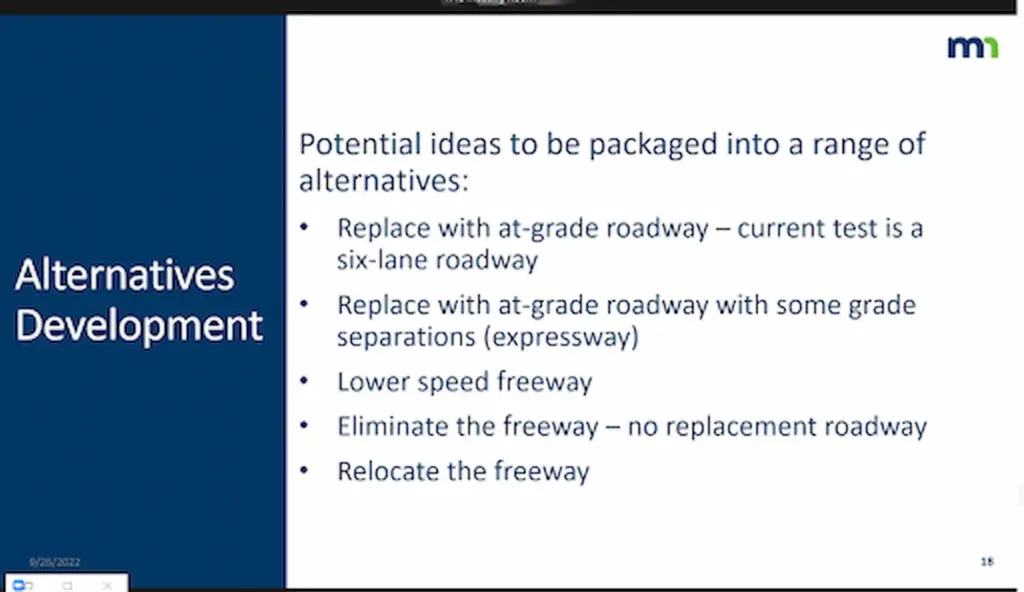

The Rethinking I-94 Policy Advisory Committee (PAC) met on Monday, September 26 to share updated project documents and discuss the upcoming project alternatives. Here is a meeting recap, including key takeaways from what was presented, and next steps for the Rethinking I-94 project and Twin Cities Boulevard movement.
11/28 UPDATE: MnDOT has uploaded the September 27 PAC meeting summary and presentation slides here.
Meeting Context
The Rethinking I-94 Policy Advisory Committee (PAC) is made up of key decision makers, including many elected & appointed officials from the project corridor. As the project progresses, MnDOT provides regular updates to the PAC and seeks their feedback. This was the first PAC meeting since February 2022.

Meeting Recap & Key Takeaways

1. MnDOT reveals new project documents.
The changes are a step toward truly “Rethinking I-94”, but major concerns remain.
During the PAC meeting, MnDOT unveiled new planning documents, called the “Purpose & Need” documents, for the Rethinking I-94 project. These documents are an important step of the process, as they define the project goals and the criteria by which different project options will be evaluated. In other words, if they prioritize moving car traffic, it will be difficult for anything other than a rebuilt highway to be selected. However, if the Purpose & Need documents prioritize outcomes like healthier air quality, better non-driving transportation options, reduced carbon emissions, etc. the project will be more likely to consider non-highway options and the Twin Cities Boulevard would be more likely to be selected as the preferred alternative for the Rethinking I-94 project.
MnDOT amended these documents because, last year, 28 organizations and hundreds of community members expressed concern that the draft documents would have all but guaranteed a rebuilt highway and failed to properly prioritize community concerns like public health, equity, and climate. In October of 2021, these groups sent an open letter outlining these concerns to MnDOT and the Federal Highways Administration (FHWA). You can read more about the letter and its concerns here.
MnDOT presented an overview of the new documents and what changed. You can view the executive summary of the new documents here. MnDOT has not yet revealed the new draft documents themselves. We will share the full documents and provide an updated response as soon as they are made available. These documents are still in draft form so there is still an opportunity to push for improvements.
Based on the presentation and executive summary, here is a list of the positive changes and unaddressed issues.
The Good: the new documents include some positive steps toward truly “Rethinking I-94”
- Combination of primary & secondary needs. The previous documents had separated the project needs into primary needs and secondary needs, with car mobility and highway pavement condition being prioritized above all others. The new documents have eliminated this distinction. This change was requested in the October 2021 community comment letter.
- A purpose that focuses on the corridor, not the highway. Previously, the project’s purpose was defined in terms of improving I-94, which made it clear that MnDOT was not truly “rethinking” the highway or whether or not it would be rebuilt. The new purpose statement focuses on improving the “project corridor”, making space for non-highway alternatives to be considered.
- Incorporating livability into the project goals and evaluation criteria. During the meeting, MnDOT said that “livability concerns” like equity, public health, and the environment, were incorporated into the project’s goals statement and evaluation criteria (the metrics that will be used to narrow down the different project options). Additional details about these changes are not known, and we won’t know if this change was sufficient until the full documents are made available.
The Bad: MnDOT continues to dismiss the highway’s harms and prioritize moving car & truck traffic

- Continuing to define “mobility” as moving cars & trucks. The project’s needs remain focused on moving cars & trucks and reducing traffic congestion. This is a major concern and will make it difficult for anything other than a new highway to get fair consideration. It also completely ignores decades of research that shows that urban highways don’t work and expanding them only makes traffic worse. Instead, we are calling on MnDOT to focus on improving transportation access for all users, particularly those who are transit dependent, and consider induced demand and traffic evaporation in their analysis.
- MnDOT continues to dismiss the highway’s impacts and its ability to repair them. The document’s executive summary says that a majority of the identified community goals for Rethinking I-94, including public health, the environment, economics, sense of place, safety, connections, and equity, “are largely outside MnDOT’s jurisdiction”. This is not true. All of these issues are directly impacted by the highway. It is MnDOT’s responsibility to take the lead on repairing these harms through this project.
- Lumping transit with car & truck mobility. Transit and car & truck traffic have fundamentally different needs. Combining them will only ensure that the needs of transit riders continue to be ignored. We are calling on MnDOT to separate transit into a separate need, as was done for MnDOT’s I-94/252 project.
- Ignoring the highway’s impact on the climate crisis. The only mention of the climate crisis in the summary is about accounting for the future on highway infrastructure. This completely ignores the fact that transportation is Minnesota’s biggest source of greenhouse gas emissions. We are calling on MnDOT to take ownership of this problem and make reducing carbon emissions a core goal of the Rethinking I-94 project.
- No Equity and Health Assessment. After MnDOT proposed a new highway expansion project in Brooklyn Center and North Minneapolis, community backlash and concern for the project’s impact on public health forced MnDOT to conduct an Equity & Health Assessment (EHA) for the corridor to better understand existing disparities and potential impacts. However, MnDOT has not conducted an EHA for the Rethinking I-94 project corridor despite the fact that 94% of the corridor is identified as an area of concern for environmental justice. We are calling on MnDOT to conduct an EHA before moving forward with project options.
2. MnDOT reveals ideas for project alternatives.
An I-94 boulevard conversion is officially being considered, but important details remain unclear.

MnDOT also presented on the ideas that are currently being considered for the project’s alternatives. Alternatives are the official options that will be considered for the Rethinking I-94 project.
In a major victory, MnDOT confirmed that a boulevard conversion (listed as an “at-grade roadway”) will be studied and considered for inclusion in the project alternatives. This is a direct result of the thousands of community members who have contacted MnDOT and project decision makers in support of the Twin Cities Boulevard. Your voice is being heard!
While this is an important step, we do not know any details about the specific boulevard conversion designs that MnDOT is studying, nor the assumptions that are informing their analysis. For example, MnDOT’s slide says that the current design being tested is a six-lane roadway. We are concerned that MnDOT will design boulevard conversion options that do not include the core components of the Twin Cities Boulevard vision, and use misleading, car-centric traffic modeling to quickly dismiss any non-highway options as being non-feasible.
Even more concerning, MnDOT is also studying options that would not only rebuild, but would expand the highway. After six decades of harm, the fact that MnDOT is considering perpetuating injustice for another half-century shows that they are not seriously considering the health and well-being of the 100,000 people who experience these impacts daily and the community calls for reparative justice.
We are calling on MnDOT to include a wide variety of boulevard conversion design within the upcoming project alternatives. Each boulevard alternative should include the core elements of the Twin Cities Boulevard, including a multi-modal street with rapid transit, park space and reclaimed land for community-guided development.
During the meeting, multiple PAC members, including Sen. Omar Fateh’s office, amplified this call and spoke about their desire to see ambitious project alternatives that include the Twin Cities Boulevard vision.
3. MnDOT will not apply for a Reconnecting Communities grant this year.
Multiple PAC members, including Hennepin County Commissioner Angela Conley, Minneapolis Council Member Robin Wonsley, Ramsey County Commissioner Toni Carter, and State Representative Rena Moran, pressed MnDOT on why the agency was not applying for a Reconnecting Communities grant to study a highway-to-boulevard conversion for the Rethinking I-94 project. MnDOT Commissioner Nancy Daubenberger said that they didn’t want to “bias the process” by applying this year but that it is something that they will consider in future years.
We are concerned that MnDOT’s car-centric modeling will not fairly evaluate a highway-to-boulevard conversion for the Rethinking I-94 project. This is why we are asking Minneapolis and Saint Paul to apply for a grant this year to conduct this analysis, before MnDOT’s project alternatives are finalized. During the meeting, PAC member Russ Stark from Mayor Melvin Carter’s office confirmed that Saint Paul is planning on applying for a grant, but that it would likely not include a boulevard analysis. Take action by contacting the Mayor’s office here.
4. The public comment period was filled with support for the Twin Cities Boulevard
Thank you for showing up and making your voice heard!
Last but not least was the meeting’s public comment period. MnDOT has consistently made the Rethinking I-94 project process opaque and inaccessible. This continued on Monday, as the meeting took place in the middle of the workday and during Rosh Hashanah. Despite these barriers, dozens of people signed up to testify. In response, MnDOT was forced extended the comment portion by 30 minutes. Nearly every person who testified spoke about the reasons that they supported the Twin Cities Boulevard.
To all who attended and spoke during the meeting, thank you! Your collective power is the force behind all of the progress that has been made to date and will be what ultimately makes the Twin Cities Boulevard vision a reality.
Next Steps
What’s ahead for the Rethinking I-94 project.
- MnDOT will now continue to refine the project’s purpose & need documents and begin the process of designing project alternatives. We will share an updated response and action alert when the full documents are revealed.
- The next PAC meeting will take place before the end of the 2022, where MnDOT will likely share an update about the project alternatives. The next few months will be critical for making sure that MnDOT’s alternatives include a wide variety of boulevard conversion designs that adequately address the highway’s harms.
Here are a few ways to take action and support the Twin Cities Boulevard:
- Missed the meeting? Send your comments to rethinkingI94project.dot@state.mn.us before October 5 to be included in the meeting summary.
- Ask Saint Paul City Leaders to include a boulevard conversion study in their Reconnecting Communities grant application
- Share your vision for transit on the corridor & your support for the Twin Cities Boulevard at an upcoming MnDOT engagement session for Rethinking I-94. (10/7 UPDATE: Send an email to MnDOT!)
- Tuesday, October 11: 9:00 – 10:00 AM: Virtual Transit Study Public Meeting. Let MnDOT know your priorities for transit on the corridor.
- Wednesday, October 12: 8:00 AM – 8:00 PM: Transit Study Open House, Hallie Q. Brown Community Center, 270 N. Kent St., St. Paul, MN 55102. MnDOT staff will be present throughout the day to collect ideas and input for transit as part of the Rethinking I-94 project.